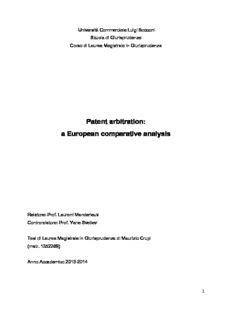
Patent arbitration: a European comparative analysis PDF
Preview Patent arbitration: a European comparative analysis
Università Commerciale Luigi Bocconi Scuola di Giurisprudenza Corso di Laurea Magistrale in Giurisprudenza Patent arbitration: a European comparative analysis Relatore: Prof. Laurent Manderieux Controrelatore: Prof. Yane Svetiev Tesi di Laurea Magistrale in Giurisprudenza di Maurizio Crupi (matr. 1352269) Anno Accademico 2013-2014 1 2 A mio padre, “Allora il re ordinò: «Prendetemi una spada!». Portarono una spada alla presenza del re. Quindi il re aggiunse: «Tagliate in due il figlio vivo e datene una metà all'una e una metà all'altra». La madre del bimbo vivo si rivolse al re, poiché le sue viscere si erano commosse per il suo figlio, e disse: «Signore, date a lei il bambino vivo; non uccidetelo affatto!». L'altra disse: «Non sia né mio né tuo; dividetelo in due!». Presa la parola, il re disse: «Date alla prima il bambino vivo; non uccidetelo. Quella è sua madre». Tutti gli Israeliti seppero della sentenza pronunziata dal re e concepirono rispetto per il re, perché avevano constatato che la saggezza di Dio era in lui per render giustizia”. 1 Re 3, 24-28 3 4 Table of contents……………………………………………………………………….. .. .. 5 Introduction…………………………………………………………………………………. 9 Chapter 1 PATENT ARBITRATION: A GENERAL PERSPECTIVE 1.1. Arbitration: definition and differences with other ADRs………………..……... 11 1.1.1. The true nature of arbitration…………………………………………... ...16 1.2. A problem of arbitrability……………………………………………………….... 22 1.2.1. Conceptual differences between validity and arbitrability……………... 24 1.2.2. Issues in matter of competence and jurisdiction……………………….. 25 1.2.3. Mandatory norms and public policy……………………………….…….. 32 1.3. Concluding remarks on arbitrability………………………………...................43 Chapter 2 PATENT ARBITRATION IN EUROPE 2.1. Introduction……………………………………………………………………….. 45 2.2. A comparative perspective……………………………………………………… 47 2.2.1. Countries that allow a complete arbitrability of the disput…………...... 49 2.2.1.1. Switzerland…………………………………………………………. 50 2.2.1.2. Belgium……………………………………………………………... 56 2.2.2. Countries that allow arbitrability on patent validity with inter partes effects……………………………………………………………………... 58 2.2.2.1. Great Britain………………………………………………………… 58 2.2.2.2. France……………………………………………………………..... 62 2.2.3. Countries that allow arbitrability only for patent infringement………… 67 2.2.3.1. Sweden……………………………………………………………... 67 2.2.3.2. The Netherlands…………………………………………………… 73 2.2.3.3. Austria………………………………………………………………. 74 2.2.3.4. Spain………………………………………………………………... 76 2.3. Germany: a peculiar case……………….……………………………………….79 2.4. Concluding remarks on the comparative perspective………………………… 84 5 Chapter 3 THE ITALIAN CASE 3.1. Patents: a definition under the Italian i.p.c……………………………... ……... 89 3.2. The Italian legislation on patent arbitration…………………………………….. 93 3.2.1. Introduction………………………………………………………………... 93 3.2.2. A problem of arbitrability………………………………………………..... 93 3.2.2.1. Inarbitrability before the arbitral tribunal…………………………. 95 3.2.2.2. Inarbitrability of the dispute as a ground of appeal……………... 97 3.2.2.3. Inarbitrability of the dispute at the time of recognition or enforcement of the award…………………………………………. 98 3.2.3. Article 806 c.c.p…………………………………………………………… 98 3.2.3.1. Patent arbitration…………………………………………………… 104 3.2.4. The role of the public prosecutor………………………………………… 105 3.2.5. The proceedings regulated by the i.p.c…………………………………. 105 3.3. Concluding remarks on Italian legislation……………………………………….117 Chapter 4 ROLE OF ARBITRATION IN PATENT DISPUTES 4.1. Advantages of arbitration………………………………………………………... 119 4.1.1. Flexibility of the procedure……………………………………………….. 119 4.1.2. The choice of the seat of arbitration……………………………………...121 4.1.3. Qualities and role of the arbitrators……………………………………… 122 4.1.3.1. Impartiality of the arbitrators………………………………………. 122 4.1.3.2. Competence and experience of the arbitrators…………………. 124 4.1.4 Confidentiality……………………………………………………………… 125 4.1.5. Length of the proceedings……………………………………………….. 132 4.1.6. Role and importance of administered arbitration………………………. 136 4.1.7. The decrease of the number of conflicts and the safeguard of the economic relationships…………………………………………………... 138 4.1.8. Circulation of the awards…………………………………………………. 139 6 4.2. Disadvantages of arbitration…………………………………………………….. 140 4.2.1. Costs……………………………………………………………………….. 140 4.2.2. Absence of coercive measures………………………………………….. 141 4.2.3. Subjective limits…………………………………………………………… 143 4.3. Arbitration under Italian public contracts: the role of the TTOs………………. 143 4.4. Concluding remarks on the importance and role of IP arbitration…………….148 Chapter 5 THE FUTURE OF PATENT ARBITRATION AND CONCLUSIONS 5.1. Introduction………………………………………………………………………...151 5.2. The situation in Europe………………………………………………………….. 152 5.3. The nature of the dispute and reasons for avoiding ADRs…………………....157 5.4. Conclusion………………………………………………………………………....162 Bibliography and sitography…………………………………………………………….. 165 Case law…………………………………………………………………………………...178 7 8 Introduction. The purpose of this work is to provide an answer to the question of arbitrability of patent disputes. The analysis starts from the definition of arbitration and its classification in the broader category of ADRs, with particular reference to the concepts of arbitrability and public policy. The synchronic and diachronic comparison, carried-out with regard to the main European legislations, will highlight the national answers to the question of arbitrability of patent disputes, in particular in matter of validity of the patent. In the following chapters, the discussion will start from the solution adopted by the Italian Legislator and will continue with the analysis of the statistics on the use of arbitration in Italy. A particular attention will be given to the observations of the legal and management reasons that could prevent the economic operators, both public and private, from choosing arbitration, preferring to instigate the proceedings before the ordinary judge. In this sense it will be provided a neutral analysis on the pros and cons in the use of arbitration for the resolution of IP disputes, also with reference to the experiences of two internationally renowned Groups. In conclusion, the analysis will focus on the legislative innovations at the European level, with particular regard to the Community patent and the Agreement on the Unified Patent Court. 9 10
Description: